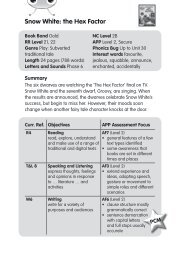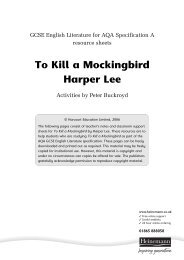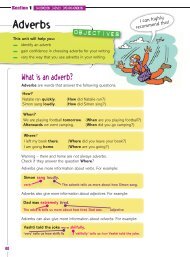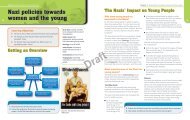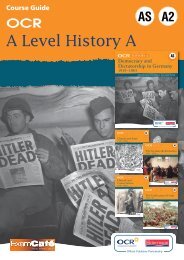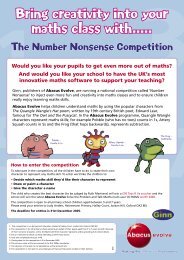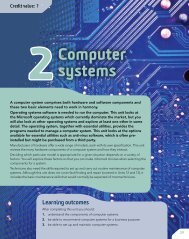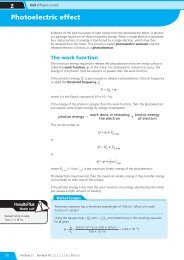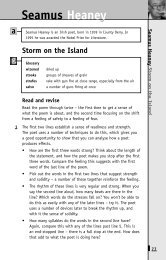Freak the Mighty - Pearson Schools
Freak the Mighty - Pearson Schools
Freak the Mighty - Pearson Schools
Create successful ePaper yourself
Turn your PDF publications into a flip-book with our unique Google optimized e-Paper software.
2<br />
Teaching sequence:<br />
• Draw attention first to <strong>the</strong> four categories of Max’s reactions and<br />
ensure that pupils understand ‘overwhelmed’ and ‘powerless’.<br />
• Model aloud and show on <strong>the</strong> board <strong>the</strong> thought process of<br />
placing a quotation within a category. Try to convey <strong>the</strong><br />
importance of identifying, by underlining, <strong>the</strong> key words of <strong>the</strong><br />
quotation. Which of <strong>the</strong> words helps me to decide how Max is<br />
reacting? Model also what happens when a quotation can be<br />
placed in two of <strong>the</strong> categories: choosing <strong>the</strong> ‘best fit’ and<br />
explaining how that decision was arrived at.<br />
• Organise pupils into pairs to begin with, to card-sort <strong>the</strong><br />
quotations from Chapter 16, discussing <strong>the</strong> language,<br />
categorising <strong>the</strong> quotation and identifying <strong>the</strong> key word(s).<br />
• Pairs of pupils join to make groups of four and to explain how<br />
<strong>the</strong>y have categorised <strong>the</strong>ir quotations. The groups of four<br />
should circle in colour any of <strong>the</strong> quotations about which <strong>the</strong>y<br />
strongly disagree.<br />
• As a class, discuss some of <strong>the</strong> quotations that were most hard<br />
to categorise. Re-model on <strong>the</strong> board <strong>the</strong> exercise of focusing on<br />
<strong>the</strong> key word in <strong>the</strong>se quotations, to reinforce <strong>the</strong> importance of<br />
this process. Draw out that sometimes <strong>the</strong> language of a text<br />
can be interpreted in different ways or in more than one way.<br />
• Ask for four volunteers to stand at <strong>the</strong> front of <strong>the</strong> room and<br />
give each of <strong>the</strong>m one of <strong>the</strong> following quotations, blown up<br />
onto A3 paper, so that <strong>the</strong>y are visible from <strong>the</strong> back of <strong>the</strong><br />
room:<br />
‘I’m thinking this weird thought: He doesn’t need a<br />
suit of armour.’<br />
‘I’m so weak, I can hardly put my shoes on.’<br />
‘He’s everything all rolled into one, and no one can ever<br />
beat him, not even <strong>the</strong> brave Lancelot.’<br />
‘Somehow I always knew that this would happen, that<br />
he would come for me.’<br />
• Explain to pupils that all of <strong>the</strong>se quotations suggest Max’s<br />
feelings of being powerless, but some more than o<strong>the</strong>rs. Which<br />
order should <strong>the</strong>y be in? Label one end of <strong>the</strong> room ‘Powerful’<br />
and <strong>the</strong> o<strong>the</strong>r end ‘Powerless’. The rest of <strong>the</strong> class make<br />
suggestions about where each of <strong>the</strong> quotations should be<br />
placed on this spectrum and why. Encourage higher attaining<br />
pupils to explain by referring to a single key word in <strong>the</strong><br />
quotation.<br />
<strong>Freak</strong> <strong>the</strong> <strong>Mighty</strong> Teacher Resource Sheet 12<br />
©<strong>Pearson</strong> Education 2006



